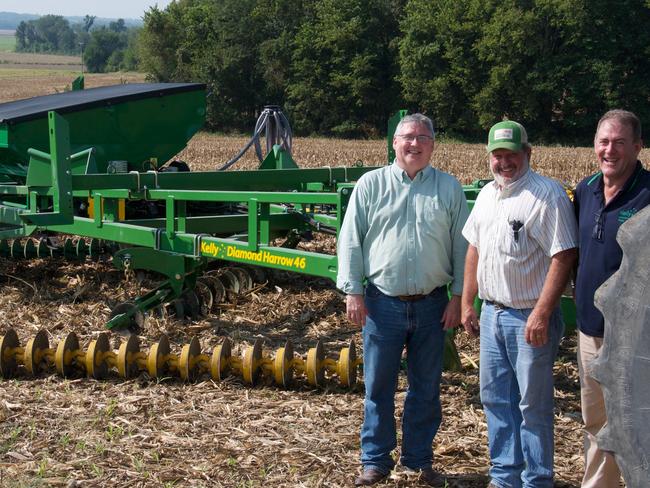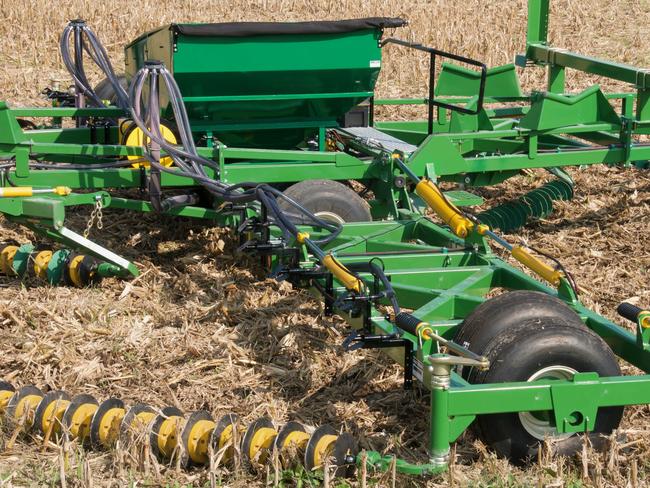A SOUTH Australian company is getting in on the ground floor of the US cover crop boom with its diamond harrow seeder.
COVER cropping is a new catchphrase in the US according to South Australian engineer Shane Kelly, whose diamond harrow with a broadcast seeder attached is built to capture the market.
The idea of the machine is to scratch up just enough surface to sow a crop of canola or some other small seed variety to act as a fertiliser for a cash crop sown into it afterwards.
It’s not new or revolutionary but Kelly says government subsidies in the US mean the spotlight is on the technique and he’s “getting in on the ground floor”.
“We went to the US because that’s where there has been the biggest drive towards cover crops and it’s becoming a mainstream conversation,” he says.
“There has been a real push towards cover crop establishment through US Department of Agriculture subsidies and industry groups pushing the method. There are environmental benefits, whether it be nutrient recycling, erosion control, soil improvements or water run-off.
“It became apparent this was an emerging sector in the States and there was no methodology and nobody owns that space yet.
“We’ve had our diamond harrows there for a while now so we thought it was a good opportunity to get in on the ground floor.”

Chain gang: Kelly Engineering US sales manager Wayne Rosenbaum, left, George Quinn of DQ Precision Planting Equipment and Kelly Engineering managing director Shane Kelly.
The North Central Sustainable Agriculture Research and Education program and the Conservation Technology Information Centre in the US estimate there was an almost 40 per cent increase in the number of farmers planting cover crops from 2012 to 2013.
According to the US Census of Agriculture more than 130,000 farms used cover crops on 4.2 million hectares in 2013.
SARE has set a target of eight million hectares in the US by 2020.
Common types of cover crops in the US include rye, wheat, barley, field pea, canola and mustard.
Previously, cover crops were viewed as being too expensive because of the requirement to maintain fields and machines year-round.
In Australia, cover cropping doesn’t have a lot of fans.
“We have some guys in no-till using it in South Australia and there are areas in southern Queensland and northern NSW that lend themselves to it,” Kelly says.
“But in most of the wheatbelt you don’t want moisture being sacrificed for a cover crop when you’re trying to build a cash crop.”
However, he said there was scope for more Australian farmers to employ the technique, especially in no-till systems.
“It works neatly in conjunction with no-till,” Kelly says.
“When guys are establishing their cash crop with no-till, they don’t want to come back and work their ground unnecessarily.
“To come back into stubble you need to let it weather down or process the stubble some way to get through it.
“So to have something you can use to get straight back into the stubble and broadcast a crop into it, as well as stimulate the germination, fits in quite neatly with a cover crop process.”

Broadcast news: The Kelly cover crop seeder broadcasts small seeds over chain-tilled stubble.

Broadcast news: The Kelly cover crop seeder broadcasts small seeds over chain-tilled stubble.
His machine is designed to initiate better microbial action in the soil by promoting the decomposition of residue in the top layer. Kelly says this lets in more sunlight, which dries the soil and helps kill weeds.
It employs chains in a diamond shape with a row of crop-specific metal discs that rotate and penetrate the soil.
Attached to it is a seed hopper and spreading unit underneath, built by engineers PJ Green in Geelong, which broadcasts seed.
“Growers in Victoria have been using chains to establish canola crops for years with PJ Green air carts with 600-800-litre hoppers that are ideal for canola and pasture grasses,” Kelly says.
“This is the first time we’ve scaled it up to 50-60kg per hectare range with a hopper mounted to the machine.”
Importantly the Kelly Cover Crop Seeder (“It’s a working title until we come up with something catchier,” says Kelly) is simple and not expensive with a 14m-wide machine retailing at about $120,000.
“Farmers aren’t using it to sow a cash-generating crop, so they want to do it as cheaply and efficiently as they can,” Kelly says.
While the concept of a chain disc harrow is simple, it’s still fairly niche in Australia with tine harrows far and away the most popular method and disc harrows also starting to have more of an impact on the market.
However, Kelly says tine and disc harrows can exacerbate weed issues.
“As soon as we start discing or cultivating, we start burying weed seeds and spreading their germination over one or two years rather than making it happen quickly,” he says. “The diamond harrow just tries to scarify the surface without turning soil over and burying weed seeds.
“We’re looking to process the residue on top, level the surface and prepare a seedbed with good soil/seed contact.”
The cost of running a diamond harrow is also much cheaper than other methods.
“Wear costs on the diamond harrow are in the order of 30 cents per acre and the machine will go for many years without spending anything significant,” Kelly says.
“A new set of chains after 40,000 hectares would cost around $25,000.”
Kelly’s machine is completing trials in the US and he says he’s expecting it to be available here next year. Whether or not it finds a market in Australia might not matter if it takes off overseas, but Kelly is hopeful it will.
“It’s a bit like no-till,” he says. “Once it got started, it moved in very quickly and everyone had a go at it one way or the other.”


